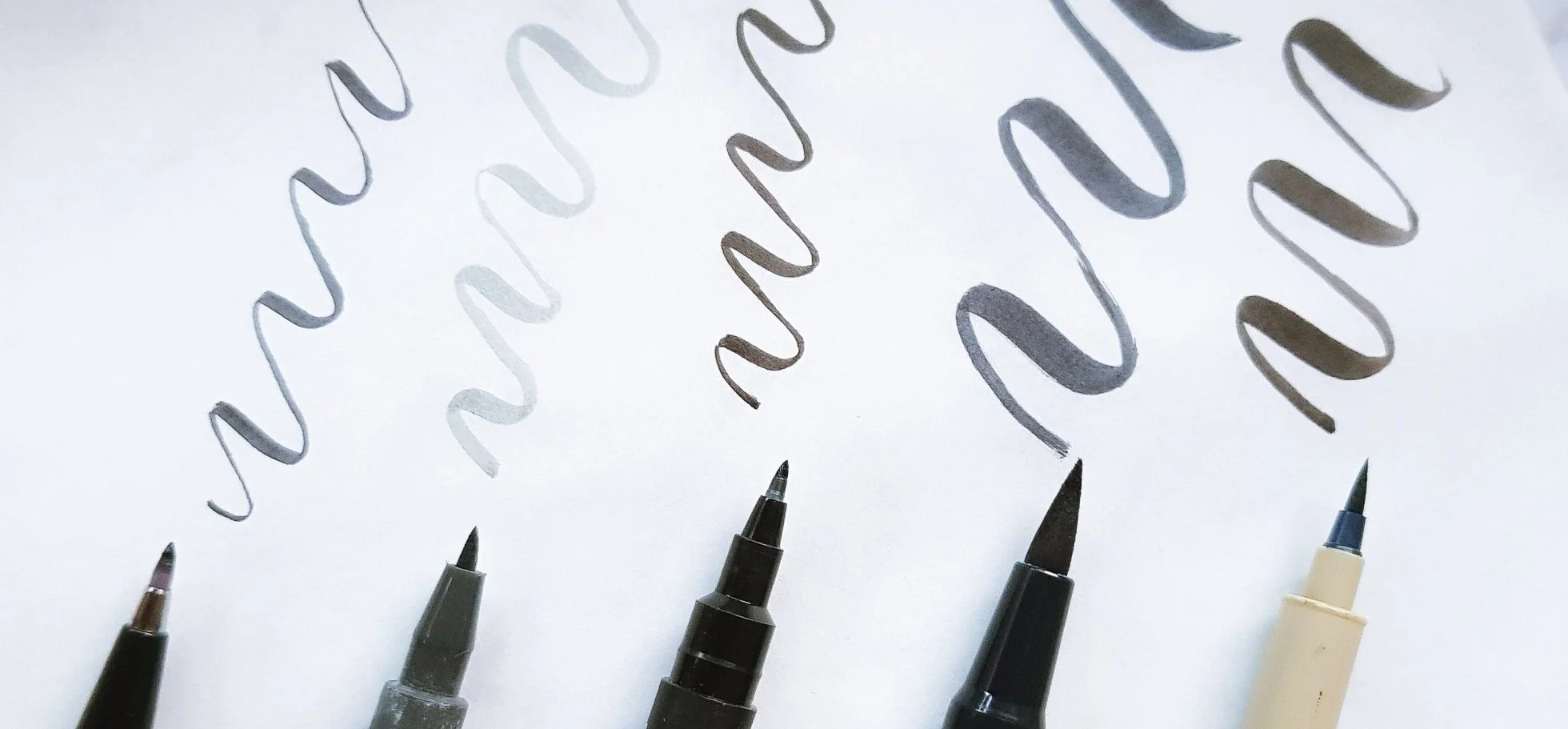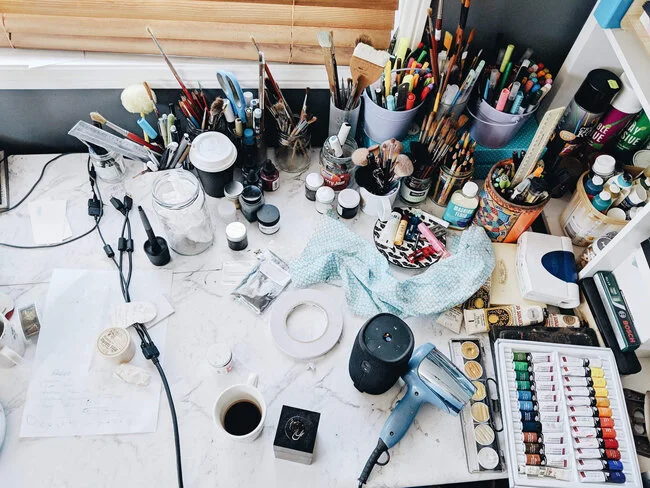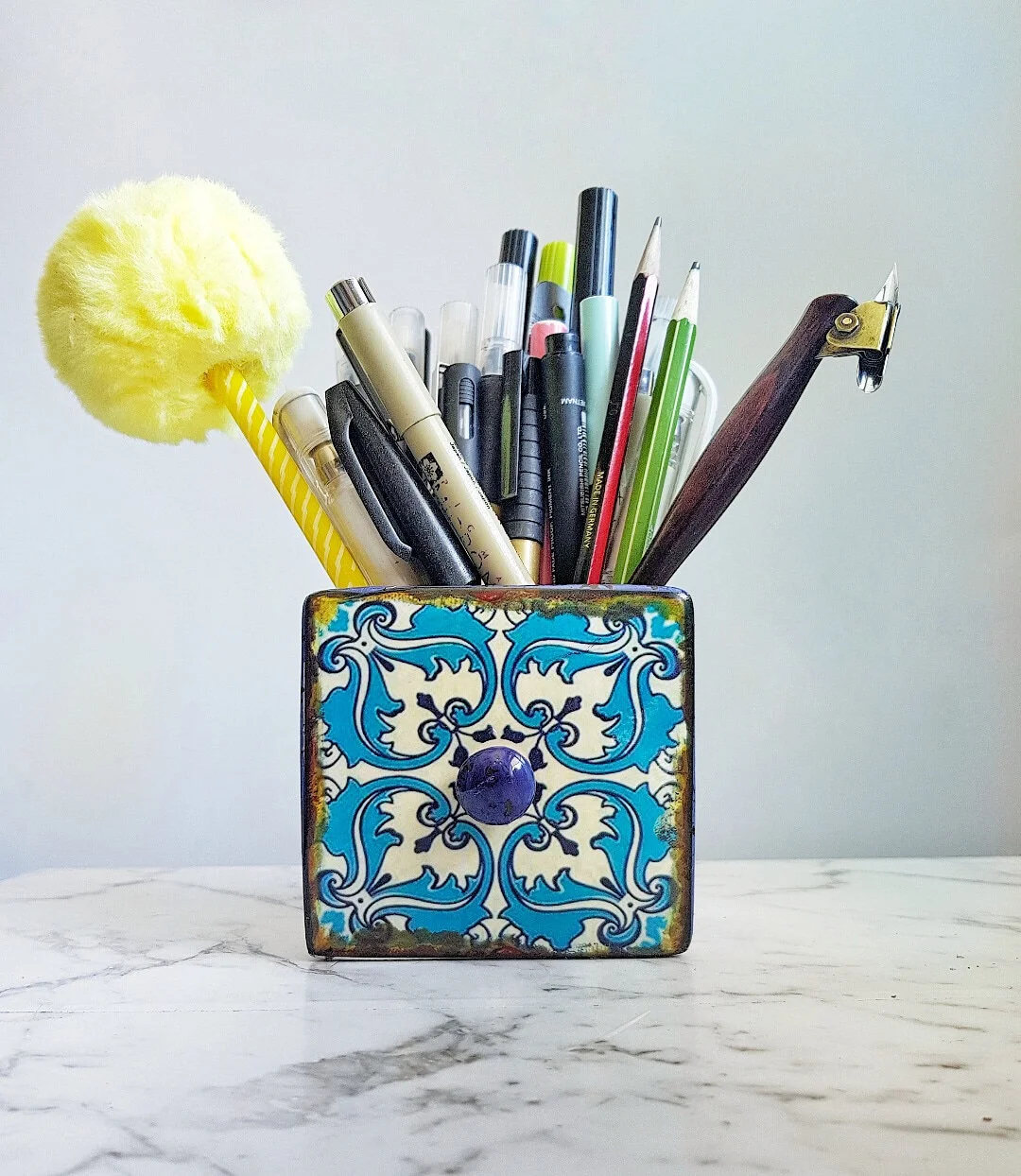Tools for Brush Lettering
A run through on the basic tools & supplies you need for brush lettering in Australia
BRUSH PEN
A brush pen is a pen that emulates a brush, but vary in a number of ways:
NIB SIZE - The wider the nib at the base means the thicker the stroke when you press fully. This means higher contrast with your thin strokes, and your lettering will much larger and require more paper space. The sharper the tip of the nib means thinner lines on your light strokes. Technically you can achieve those light thin strokes on all brush pens, but it's easier when the nib returns back to its intended original shape.
NIB FLEXIBILITY - A firm nib means it's harder to press down and get those thick strokes then it is on a softer nib. When starting it's better to work with pens with a firmer flex as the extra resistance makes it easier to control and maintain consistent pressure. Most pens just come with the one level of flex, but some like the Tombow Fudenosuke come in a variety of flexibility.
NIB MATERIAL - Brush nibs either come with bristles like a brush or with a felt tip.
When I want the bristle, brush effect I tend to just opt for an actual brush with ink, but when I do I usually go for popular options the Aquash Water brushes, Pentel Colour Brush Pens or Pentel Pocket Brush.
With the felt tips, my fave is the Pentel Sign Brush Pen. And to be honest I'm not 100% sure if it is completely made of felt, although I think it is but the nib is just so much smaller. But either way I prefer these nibs in pens like the Pentel brush and the Tombow Fudenosuke because it does not fray like the nibs in the Tombow Dual Brush pen, Ecoline Liquid Watercolour Brush Pen or Faber Castell's PITT brush pen.
INK CAPACITY - How fast you work through those pens depends on a number of factors. The size of your nib and pen is first, larger pens usually run out incredibly quickly because the nib needs that much more ink to function.
You can replace or replenish ink cartridges in some pens, although you may have to pay a little bit more. Check out this selection on Jet Pens for a good round up of all pens. You can buy some of these in Australia like the Pentel Colour Brush Pens, Pentel Pocket Brush Pen, or the Pilot Parallel Pen (although this is a broad nibbed pen).
From left to right: Pentel Sign Brush Pen, Faber Castell PITT Brush Pen, Uni Pin Fineline Brush, Tombow Dual Brush Marker & Pigma Brush
PAPER
Most beginners start lettering on simple printer paper found lying about the house. Standard weight of printer paper is 80gsm and is thin enough to see thick black guidelines underneath and still hold its own.
In the past year or so I've switched to using rolls of baking paper to practice and create pieces on, as it's far cheaper and easier to purchase than tracing paper.
When creating keepsakes and lettering pieces to gift, I use watercolour paper of whatever thickness I prefer or need for the project. When lettering with pointed pen calligraphy, I will work with hot pressed paper as it has a smoother finish with less 'teeth' on the paper. For other lettering tools like brushes, brush pens or mixed mediums I will use cold pressed paper to get that watercolour paper texture. The term 'hot' and 'cold' comes from the method of how the paper is made. To help remember, think of hot pressed paper as smoother because someone ironed out the creases.
The porosity of your medium, or how much your chosen surface soaks up your ink, for example printer paper soaks up more than tracing or baking paper. You can tell this usually by how smooth your paper is and wet like your work looks like. Just be wary as the ink will take longer to dry so it will be easier to smudge. Other smoother paper options include Rhodia or Clairefontaine (my favourite) that you can get from Officeworks.
Tip: GSM means 'grams per square meter' and tells you the weight of the paper, or in other words the thickness of a piece. To help some approximate gsm paper weights are,
Tracing paper, 40 gsm
Printer paper, 80 gsm
Greeting cards, 220-280 gsm
300+ gsm, luxury greeting cards and invitations
Baking paper on the left, Printer paper on the right and watercolour paper on the bottom
PENCIL
I tend to use a HB very lightly pencils to sketch layouts and compositions, and to keep and correct lines and strokes in my pieces. The difference between pencils like 2B, HB and 2H etc is the density of the granite within the pencil.
ERASER
I use any clean, white eraser to remove any lines. Be extra careful when erasing on baking paper! The thinner paper makes it much easier to crinkle and rip when erasing. When you do, try to erase from the centre of the paper to the edges in one direction. There's nothing worse than creating an amazing piece and ripping it *cries
RULER
My rulers are either 15cm for smaller work, or 40cm for larger pieces. A clear good ruler helps me see through to help draw those clear lines relative to other lines. I used to be a big fan of the rolling ruler but have since moved on out of personal preference.
Making sense of it all. Photo by Lecinda Ward Photography
GUIDE SHEETS
Guide sheets are to keep your lines and word heights in check. Being a graphic designer, I was able to create my own that work to my style. You can get them for free in my shop, and check out my blog post to see how to use them.
LEARNING MATERIALS
Like starting any creative endeavor or learning a new skill, start small to progress and commit for a longer period of time. Using the tools mentioned here, you want to start with the basic strokes, then move to creating letters, words and then layout and composition. Of course rules are made to be broken but it’s good to get the foundations down pat first and that’s my recommendation.
To get started you can get the the beginning of my workshop by popping in your email below in the footer. But other great learning lettering resources that I have used include:
Online Courses - Skillshare, YouTube, Creative Live
Other Letterers - Lauren Hom, Ian Barnard, Gemma O Brien,
Meet Ups & Communities - Brisbane Hand Lettering Meetup, The Futur, Typism, Lettering Daily
QUESTIONS?
Let me know in the comments below if there’s anything you’d like me to touch on!






